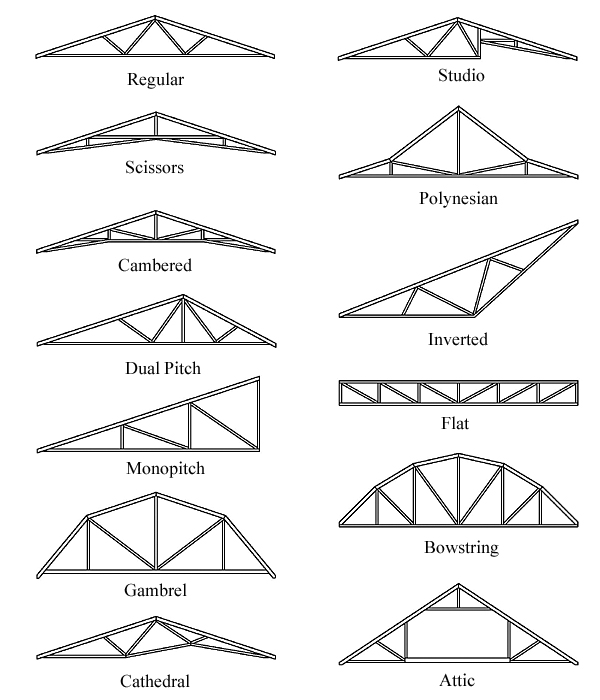ROOF TRUSSES - Different Types & Styles
On this page we show a sample of some of the mostly used roof trusses. &Other types of trusses can also be custom designed and manufactured to fit your needs.

Truss Types:
Image on this page shows different roof truss types used in residential, commercial, farm and other types of buildings. Most of the barns are built using Regular or Gable Truss design with different roof slopes. The most affordable way to build a pole barn is to use Regular Gable Trusses with 4/12 roof pitch and space them 48" o.c. (note: if using shingles on roof, trusses must be spaced 24" o.c.). The reason why regular truss with 4/12 pitch is the most affordable is because it's easier to build, takes less material and is considered a stock item at many lumber yards that specialize in selling pole barn materials.
List of Roof Trusses:
- Regular (Common)
- Scissor Type
- Cambered
- Dual Pitch
- Monopitch
- Cambered
- Gambrel
- Cathedral
- Studio
- Polynesian
- Inverted
- Flat
- Bowstring
- Attic
TRUSS USES
Regular (Common) Truss - The most affordable and widely used truss design in residential and pole building industry.
Scissor Truss - Due to sloped bottom chord, this truss provides more headroom on first level. Provides cathedral ceiling.
Cambered Truss - Provides extra first level headroom and flat ceiling in mid-section.
Dual Pitch Truss - Top chords are built with two different roof slopes, with a front slope usually steeper than back slope.
Monopitch Truss - May be used to build overhangs, single sloped roofs or longer-span Common truss with center support.
Gambrel Truss - Used mainly for its style to resemble a "barn look". May also be built with storage attic.
Cathedral Truss - Also know as Vault truss is used to provide a Vaulted ceiling.
Studio Truss (Studio Vault) - Used to provide an extra headroom or a Vaulted ceiling in certain application.
Polynesian Truss - Has a dual pitch top chord where the slope significantly increases from the heel to the peak.
Inverted Truss - Requires two bearing supports and is often used to build a Double Inverted Truss with Vaulted ceiling.
Flat Truss - Has two parallel chords and is used to build a floor or a roof.
Bowstring Truss - Is used where curved roof surface is required and is built with short top chord segments.
Attic Truss - Is used to provide storage space up in the attic. Bottom chord of the room floor is built with heavier timber and is designed as a floor joist to carry required live loads.
NOTE: Many other configurations and shapes of trusses may be built by altering top or bottom chord of a truss. When designing a truss, many factors such as snow loads, wind loads, live, dead loads, etc. must be taken into consideration. A truss manufacturer must either hire an engineer or often has an engineering department to design each truss per required codes.
